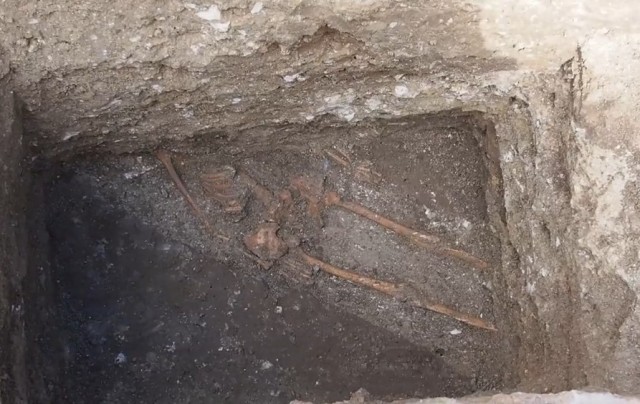‘Giant’ Man’s Skeleton Found under Odessos Fortress Wall in Bulgaria’s Varna Turns Out to Be ‘Only’ 165 cm Tall

The unearthed 4th-5th century AD skeleton of the tall man buried under the Odessos fortress wall has been lying “in situ” since it was found on March 17, 2015. Photo: TV grab from Nova TV
The allegedly “tall man” whose skeleton of an allegedly tall man has been discovered under the fortress wall of the ancient city of Odessos in Bulgaria’s Varna during rescue excavations has turned out to have been “only” 165 cm (about 5 feet 4 inches) tall, lead archaeologist Valeri Yotov has announced.
Ever since the skeleton’s discovery on March 17, 2015, Prof. Dr. Valeri Yotov from the Varna Museum of Archaeology has been seeking to convince the media and passers-by in the downtown of the Black Sea city of Varna that the seemingly tall man’s skeleton was really not such an important discovery compared with the Late Antiquity fortress wall under which he is lying, and that the ancient man was certainly not a “vampire” or an “Atlantis giant”.
The stories about the “giant” man have been fueled further by the fact that the archaeologist did not excavate his skeleton in full for more than 12 days, and, respectively, have been unable to measure him, and announce his size.
On Saturday, March 28, 2015, however, Yotov told local news site Varna Utre that the actual size of the ancient man turns turns out to be modest – “only” 165 cm, or about 5 feet 4 inches.
Even keeping in mind the fact that people were relatively shorter in ancient times, and that the Varna man was probably about average in size, the announcement is expected to debunk the media reports about the “giant” found in Varna.
Yotov has also announced the discovery of three more skeletons nearby which has led the Varna archaeologists to completely change their working hypothesis about the finds, as they now believe they have discovered an ancient necropolis under the Late Antiquity fortress wall of Odessos (known in Roman times as Odessus) which is older than the fortress wall itself.
They previously believed that the man in question, whose skeleton is dated back to the late 4th century or early 5th century, was probably a construction worker who died during the construction of the Odessos (Odessus) fortress wall, possibly from a work-related incident, and was buried right on the spot, in a deeper pit dug up for construction purposes.
The archaeologists from the Varna Museum are yet to study the newly found ancient necropolis in depth, and to try to figure out why the Late Antiquity fortress wall, which is just one of Odessos’s several fortress walls dating from different time periods, was constructed on top of a cemetery.
However, more answers will probably come in the fall of 2015 as the rescue excavations in the Varna downtown will be frozen for the summer tourist season.
Read more details about the newly found necropolis in Bulgaria’s Varna.
Background Infonotes:
The dawn of Varna‘s history dates back to the dawn of human civilization, the Eneolithic Varna Necropolis being especially well known with the discovery of the world’s oldest find of gold artifacts dating back to the 5th millenium BC.
Ancient Odessos is considered the precursor of the Bulgarian Black Sea city of Varna. It was founded by Miletian Greek colonists at the end of 7th century BC, the earliest Greek archaeological material dating back to 600-575 BC. However, the Greek colony was established within an earlier Ancient Thracian settlement, and the name Odessos had existed before the arrival of the Miletian Greeks and might have been of Carian origin. Odessos as the Roman city of Odessus became part of the Roman Empire in 15 AD when it was incorporated in the Roman province Moesia. Roman Odessos is especially known today for its well preserved public baths, or thermae, the largest Roman single structure remains in Bulgaria, and the fourth largest Roman public baths known in Europe.
The First Bulgarian Empire (680-1018 AD) conquered Odessos (Varna) from Rome‘s successor, the Eastern Roman Empire, or Byzantium, in the late 7th century. It is even believed that the peace treaty in which the Byzantine Empire recognized the ceding of its northern territories along the Danube to Bulgaria was signed in Odessos. The v(val) that the first ruler of Danube Bulgaria, Khan (or kanas) Asparuh built at the time as a defense against future Byzantine incursions is still standing. Numerous Ancient Bulgar settlements around Varna have been excavated, and the First Bulgarian Empire had its first two capitals Pliska (681-893 AD) and Veliki (Great) Preslav (893-970 AD) just 70-80 km to the west of Varna. It is suggested that the name of Varna itself is of Bulgar origin. In the Middle Ages, as a coastal city, Varna changed hands between Bulgaria and Byzantium several times. It was reconquered for the Second Bulgarian Empire (1185-1396 AD) by Tsar Kaloyan (r. 1197-1207 AD) in 1201 AD.
The Varna Hole is a pit dug up for the construction of a department store in 1984 but abandoned after the collapse of Bulgaria’s communist regime in 1989. It is presently used as a paid parking lot. It is intriguing because it features remains of the Ancient Roman fortress wall of Odessos / Odessus dating back to the 1st century AD as well as preserved walls of the Ancient Greek colony of Odessos dating back to the 5th century BC.











